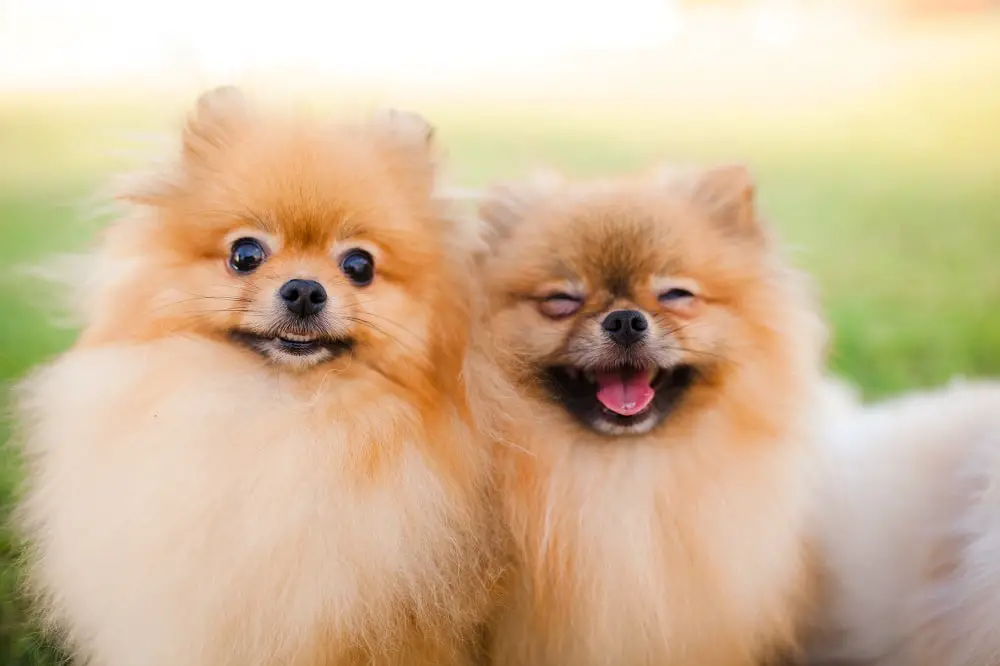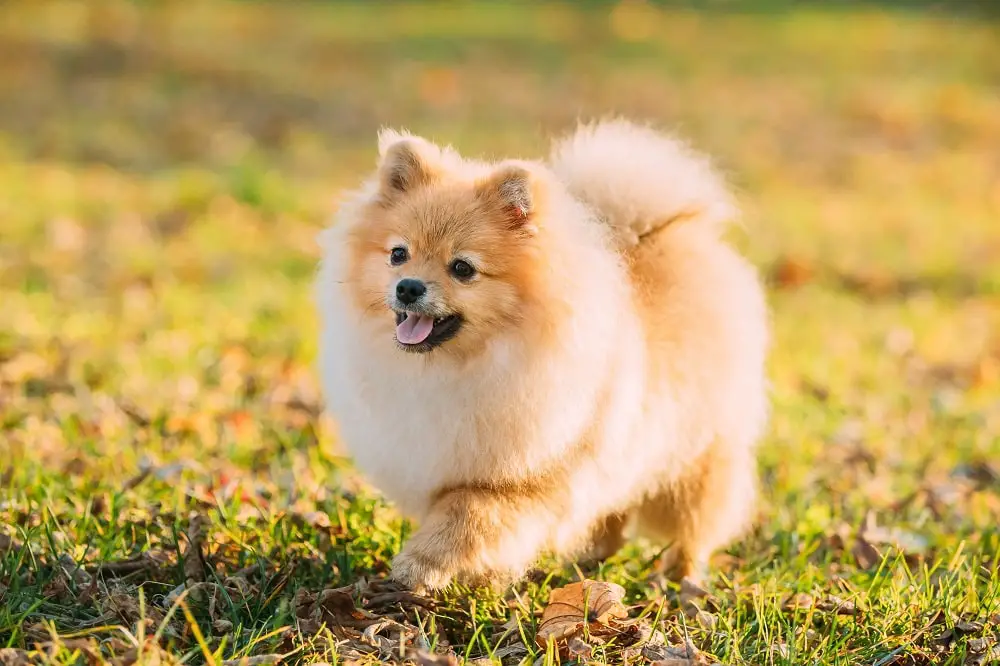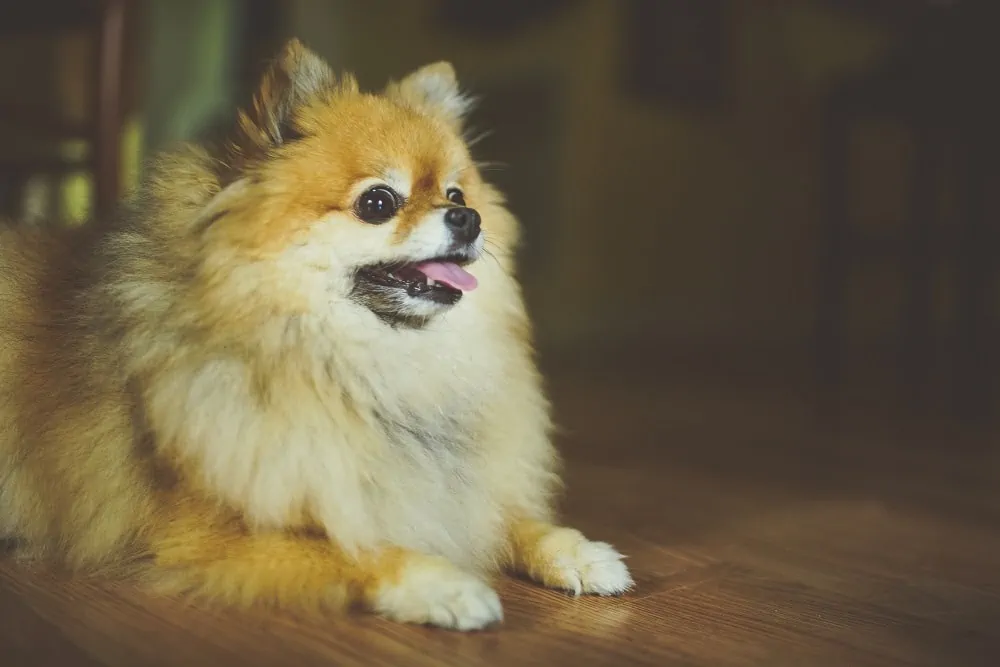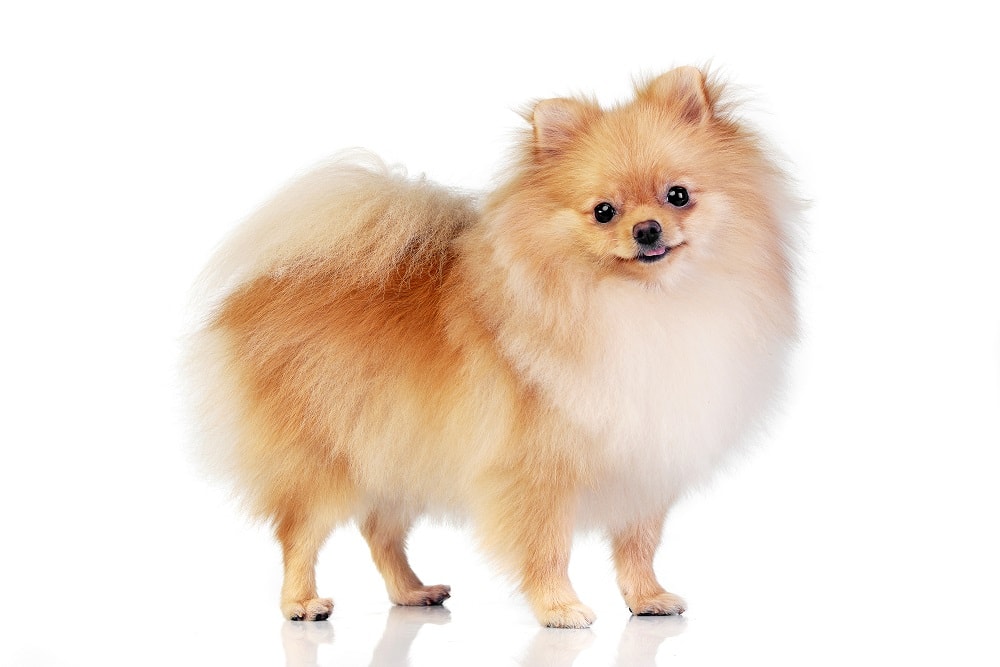Pomeranians have appeared throughout history, judging by numerous painted portraits, but it might surprise you to know that the dog did not always look like a spoilt cotton ball with button eyes. There was a time when Pomeranians were actually working members of the spitz breed.
Do Pomeranians make good pets? Yes, Pomeranians make good pets. Pomeranians are loving, energetic, charismatic, and trainable, thus providing a variety of reasons why they make delightful pets for both old and young. As an intelligent breed, the Pomeranian will require a strong pack leader to help them understand their role in the home.
Having the title of being one of the top 20 most popular breeds in America, the Pomeranian has traveled a long way from its roots to make a lot of people in the USA extremely happy dog owners since at least 1998 (source).
Pomeranian History

Before the Pomeranian became a prize of the British royalty, arriving with Queen Charlotte when she married King George III in 1761, the Pomeranian was regarded as a close cousin of the wolf by virtue of its coloring and furry good looks (source).
The Pomeranian, historically from the land of Pomerania bordering Poland, Germany, and the Baltic Sea, actually comes from a significantly burlier stock that was once bred to pull sleds, protect livestock, and guard homes.
The smaller offspring were kept around the home as pets, which is where the current breed as we know it presumably originated from. No more than 20 inches in height now, the Pomeranian is truly an arctic dog-sized package of energy wrapped in a teeny-tiny ball of fluff.
While the dog might have been downsized through selective breeding, nothing could scale down their mighty attitude, and the little Pomeranian still carries itself exactly as a majestic wolf-dog should.
Queen Victoria, the granddaughter of Charlotte, also encouraged showing and breeding thus resulting in some magnificent specimens arising. The beloved Queen once kept as many as thirty Pomeranians of different coloring through her own breeding processes.
Victoria traveled everywhere with her dogs, reportedly giving them their own personal space on the royal train under armed guard. Many of the Queen’s subjects emulated her and acquired their own Pomeranians so as to seem fashionable.
At the very first Crufts dog show, the Queen showed her 7.5-lb Pomeranian, Gena, from Florence, Italy. Judges diplomatically awarded her a Blue Ribbon as an equal winner alongside a white Pomeranian, Rob of Rozelle, that was later given the title of the very first champion of the breed.
While their true origins may never be identified, there is no doubt that the English monarchy was the first to improve the breed’s status as a pet, and little Gena became the most famous toy Pomeranian in the world.
Sadly, the Queen stopped showing her dogs when several of her prized pooches developed distemper and died after returning from an exhibition. She suspected they were infected at a show and prudently chose to keep her dogs out of the ring thereafter.
It must be said that her dogs were generally a much more robust type than is the breed standard now, and despite claims to the contrary, it was not the Queen’s plan to push the breed toward a smaller stature.
Characteristics of Pomeranians

Everything you have ever heard about dynamite and small packages is 100% true about Pomeranians. A Pomeranian has an over-inflated sense of its own size and abilities, not realizing that it is one of the smallest breeds in the dog world.
Appearance, Color, and Temperament
The Pomeranian is the smallest of the spitz dog breeds. Spitz breeds lived in parts of Europe and Asia and were identified by their prick ears, tails that curled up their backs, and their thick, fluffy double coats.
Most Pomeranians are between 6 and 12 inches tall and weigh 3 to 7 pounds. However, every now and then, an ordinary litter might contain a puppy that grows up to be 12 or 14 pounds as a throwback to their genetics from back in the day.
Breed Standard for Appearance
According to the American Kennel Union breed standard, as a toy, an exhibition Pomeranian with any hope of winning a ribbon should weigh in at no more than 6 pounds and stand 6 – 7 inches tall (source).
The Pomeranian’s head should be in balance with the torso when viewed from above. Ideally, it should form a wedge: broad at the back and tapering neatly to the nose. Its ears should be small, mounted high on the head, and erect.
The muzzle of the dog should be short and straight. The teeth should meet perfectly in a scissor bite. The dog’s eyes should be dark, bright, medium-sized, and almond-shaped. They should be set well back into the skull and must perfectly balance all the other facial features.
The dog should have an inquisitive, fox-like facial expression making it look alert and intelligent. Its nose should be black unless the dog is chocolate, beaver, or blue, in which case the nose will be self-colored.
A Pomeranian must have a neck set well into the shoulders with just enough length to allow the head to be proudly carried high. Its topline is level, from withers to croup. The body of the dog must be compact and square-shaped.
The dog’s chest should be oval-tapered extending to the point of the elbows with a pronounced prosternum, and its back should be short-coupled, straight, and strong. Its shoulders should be laid back, and the shoulder blade and upper arm length must be equal.
The forelegs should appear round and almost cat-like, well-arched, compact and turning neither in nor out, with the dog standing well on its toes.
The dog should have a dainty look about it that belies its strong working history. The back legs should balance the front with the thighs moderately muscled.
The thigh and lower leg length should be equal. The tail must be heavily plumed as a characteristic of its Nordic spitz genetics and should be set high and lie flat on the back.
Coat
The Pomeranian is a double-coated breed and should have a fluffy ruff around the neck. Red, orange, cream, sable, black, brown, blue, piebald, parti, brindle, tan, and Irish are all acceptable coat colors. Eyes
Dark blue eyes are common in newborn pups with the eyes changing color within 4 – 6 weeks. Poms that have blue skin pigmentation may retain their dark navy eyes into adulthood. However, light blue, blue marbled, or blue flecked eyes would be disqualified at a dog show.
Dark brown and medium brown is the most common eye color in Pomeranians. In a cream-colored dog, the rims of the eyes should be a brilliant black, making the eyes appear even darker.
Hazel eyes are a stunning mixture of browns and greens and quite common, whereas solid green eyes are exceedingly rare in Pomeranians. Some have light brown or golden-colored eyes regarded as Amber. Heterochromia can also occur where each eye is a different color.
Temperament
The Pomeranian has an extroverted nature with a bountiful spirit that makes it the perfect companion dog. Its intelligence and resilience also put it up there on the list of good competitive show dogs.
The dog is often described as fearless and proud, a loyal friend, and an intrepid explorer. Pomeranians do crave loving attention and enjoy kisses, although they are wary of strangers and people who don’t respect their boundaries.
Like any other animal, temperament is also tied in with genetics, so meeting the parents is a good way of discovering what temperament a new pup might have. Therefore, choosing properly registered quality breeders over puppy mills is vital.
Are Pomeranians Easily Trained?

A bored Pomeranian might get into all sorts of mischief if left to its own devices, so it’s crucial to make sure that rules and boundaries have been put in place and the dog is aware of what is expected from it at all times.
Pomeranians enjoy running, probably due to sleddog instincts buried deep in its genetics, so a good exercise program with regular walks is a must for the agile little dog. In this regard, the size of the home does not matter as long as the dog is properly exercised.
Puppy Training
Proper socialization and puppy training classes are essential when bringing home any new dog. Pomeranians are notorious attention-hogs, so any extra time spent outdoors with the owner is generally very well-appreciated.
Being fairly intelligent dogs and from the spitz breed, Pomeranians are happiest when occupied, so getting into agility training and dog shows from a young age is a treat for the attention-loving Pomeranian.
“Begin as you mean to go on” is the adage when you get a new pet. Whatever you allow at the beginning, a dog will expect to be able to do it until the end, so curb negative behaviors early no matter how cute you think it is.
Housebreaking
Toilet training a dog that spends most of its time indoors is crucial to ensure both owner and pup continue to live harmoniously. Due to their size, Toy breeds can easily sneak into a small space and do the dastardly deed without you even knowing until it’s too late.
When it comes to training, due to dogs not having the same memory-recall as humans, unless the dog is punished immediately, the habit to mess in sneaky small spaces will become established as the norm.
Pomeranians should, therefore, initially be crate trained to establish the correct protocols and only released into the house properly once the necessary habits have been developed and maintained for an adequate period of time.
Do Pomeranians Bark a Lot?
Pomeranians will bark at new stimuli like any dog but they can easily get into the horrible habit of barking excessively when left to their own devices. Pomeranians will display this bad habit if not properly trained and socialized as puppies, and end up barking at everything and everyone.
People living in close quarters with others should not allow their Pomeranian to bark for long periods of time as its high pitched voice could annoy even the nicest neighbor. Potential owners who plan on being out of the house all day are generally not a good fit for a yappy Toy dog.
Trainers advise ignoring a Pomeranian that is barking for attention and making a big deal of rewarding it when quiet. Ignoring does not mean without supervision. Under no circumstances should inappropriate barking or destructive attention-seeking behavior be rewarded in any way.
Are Pomeranians Aggressive?
Pomeranians seldom turn on their owners without being provoked. As with any other animal, small children should never be alone with a Pom due to their often irrational behavior (the child, not the dog), and the dog may snap at anyone who gets too close to its toys or food.
In their defense, considering the size of a toy Pom they can easily be hurt or killed unintentionally by a rough child or larger dog, which makes them slightly more sensitive to what they may perceive to be threatening behavior.
It is wholly discouraged for people with small children to get Toy breeds as the propensity for something to go wrong when a back is turned makes it dangerous and negligent to take that chance. Toy breeds are not toys and they will bite with provocation.
Are Pomeranians Cuddly?
They can be cuddly depending on how they have been handled and trained from the time they were pups. Pomeranians are very independent, but they also seek attention, so it would depend on the situation and the dog.
They may look like huggable teddy bears, but consent is critical. Also, being rather small, rough or over-exuberant cuddles may severely injure the dog and make it cuddle-shy in the future. Treat them as fragile, because they are.
Do Pomeranians Get Along With Other Pets?
Whether animals get along is usually about how they have been socialized and their general temperament. Being naturally possessive dogs, Pomeranians may have a hard time sharing their space and toys, especially if they have been an only dog for a while.
Strangely, male Pomeranians are not overly aggressive to other male Poms, and they can generally live well together.
Large dogs may inadvertently snap a Pomeranian’s neck while playing, so keeping mixed-sized dogs should be done strictly only under supervision.
That being said, they do get along with other pets and can become part of a new or existing pack if the correct steps are taken when making the introductions.
Dogs meeting each other for the first time should generally meet with one or both of them safely crated or contained.
Feeding
Food is a priority whether bringing home a puppy or an adult dog and, regardless of what the breeder or previous owner fed the dog, the new owner will have to decide on the correct food for their new pet based on affordability and value.
A Pomeranian fed a nutritious, healthy diet that receives proper exercise and care may live over 16 years. The correct food fed in the right quantities will play a huge part in the dog’s quality of life, too.
Dog treats can be used to reward good behavior or simply as an occasional treat. Overdoing treats could affect the dog’s eating habits, and unhealthy treats will no doubt negate all the value the dog gets out of a healthy diet.
Grooming
Pomeranians require regular grooming in the form of nail trims and ear wipes, but bathing needs only to happen every three months so as not to remove all essential oils from the fur. Brushing teeth with a good doggy toothpaste should be a daily activity.
Do Pomeranians Shed?
Pomeranians shed their puppy fur fairly quickly and then shed moderately throughout the year with one or two major sheds, known as “blowing the coat,” usually in fall and spring. This shedding will be noticeable between 1 to 2 months during that period.
Diet can also affect shedding with dogs fed a low nutrition diet shedding more than those fed good quality, nutritious meals.
The amount of hair shed will certainly take you by surprise when considering the slight stature of the Pomeranian, but it is still considered comparatively low.
Female Pomeranians shed more than their male counterparts, especially if they are whole or unspayed. Females blow their coat immediately after going on heat or after delivering a litter of puppies.
Check out how much do Pomeranians shed in the short video below:
While Pomeranians do shed, bald patches are uncommon unless there are underlying health conditions. Allergies, mange, thyroid problems, and even alopecia – the list of canine health concerns that affect fur growth can go on and should be checked with a vet.
Brushing the coat three times a week will help keep visible shedding off the furniture, carpets, and clothing. Failure to groom the dog regularly will result in an unhealthy, dull texture, and in serious cases, matting.
Tools to Use
Ordinary dog brushes do not do justice to the double coat of a Pomeranian. Slicker brushes and rake tools are the most effective if you want to do the job properly, as they can hook up the dead hair without damaging the undercoat.
It is generally accepted that a Pomeranian’s hair should be slightly damp when brushing so misting the dog with a good quality leave-in conditioner is the best way to go about it. Combing the hair will take out minor tangles (source).
General Care
Annual vaccinations and checkups are the norm with any animal and setting up regular dental checkups for teeth scaling and cleaning is also a good habit to maintain. There is no cheaper alternative when it comes to caring for your Pomeranian than being proactive in its healthcare.
Common Health Issues
Most purebred dogs have some health issues common to their breed, and the Pomeranian is no different. The most common health concerns can usually be picked up through regular annual vet visits. These include:
- collapsing trachea
- epilepsy
- hypothyroidism
- elbow luxation
- hip dysplasia
- early tooth loss
- shoulder luxation
- patellar luxation
- hydrocephalus
- entropion
- black skin disease
- cataracts
- generalized progressive retinal atrophy
- cryptorchidism
- patent ductus arteriosus
None of these diagnoses is a death sentence. Veterinary science has come a long way in treating dogs with these conditions and specialists are fully committed to doing even cataract/dental surgery or hormone therapy treatment if it will improve a dog’s quality of life.
While these may sound scary, there are tests that can be conducted by breeders to rule some of them out completely. Prior to breeding, a pair can be tested for their genetic predisposition for hip dysplasia, for example.
Good breeders weed out poor quality dogs and genetic mutations by not breeding with dogs that are predisposed to getting certain health issues. Backyard breeders, however, do not care what happens to your pup once you have paid the money for it and may sell you a sickly dog.
Are Pomeranians Hypoallergenic?

No, they are not. People tend to be allergic to dander and since all animals shed dead skin cells, pet dander is everywhere to be found. To confirm whether you are allergic to any particular animal, you would have to actually spend time with them.
Minimizing Allergic Reactions to Pets
Occasionally, people are allergic to some pets and not others. Owning a dog and having no allergic reaction to it does not mean that acquiring a second dog will ensure the same results. Here are some simple ways to minimize the risk of allergic reactions to new pets:
- daily grooming and regular bathing of pet
- separate sleeping areas for humans and pets
- banning pets from the bedroom
- vacuuming regularly
- washing your hands after playing with any animal
- putting Omega 3 in their dog food
- taking allergy meds
- installing an air purifier
Advantages of Owning a Pomeranian
Pomeranians are small dogs with big characters, so they are the ideal pets for people living in apartments and small homes who can’t get a big dog but really enjoy having a pup with the spirit of one.
Pomeranians have distinct alertness about them like typical guard dogs. They would actually be able to fulfill that role quite easily, if not for size, due to possessiveness over their owners and whatever they consider theirs.
They generally do not pose a threat to other animals and tend to get along well in a family with other dogs, so they can easily act as the trusty sidekick to a bigger dog and alert them to stranger-danger or trouble.
Pomeranians are extremely cute and look part fox, a part wolf with their pricked ears, thick coats, and curled over the tail. It’s a look everybody loves and not particularly high maintenance to achieve.
Disadvantages of Owning a Pomeranian
Pomeranians and young children are a disastrous combination and one that should be avoided at all costs. Being naturally suspicious and potentially temperamental, they do have the potential to become snappy if they are being mishandled.
Being a toy dog, Pomeranians are really small, but their long coats make them look much larger than they actually are. Their true size makes them super-fragile and they can be hurt or even killed in the blink of an eye by an obstreperous child or larger dog.
The Pomeranian is nobody’s fool, and this strong personality may prove problematic for owners who are more relaxed with their discipline style. If the Pomeranian sees a potential gap, it will take it, and bad habits can be difficult to break.
Without proper training, Pomeranians can be quite a handful. From barking incessantly to difficulties with being housebroken, having a Pomeranian requires significant thought and consideration toward effectively managing and minimizing all bad habits from the get-go.
Shedding and all the grooming required therefrom can be a turn off to potential owners, but it’s the price you pay for getting a great big bundle of cute. Ignoring the fur could lead to much bigger problems down the line.
All purebred dogs have certain genetic markers and predispositions due to dodgy old breeding practices like line-breeding or inbreeding. Finding a healthy dog with minimal issues requires doing some homework and speaking to the Kennel Union and other people in the know.
Final Thoughts
Most people, when getting a dog, are either looking for a specific breed based on genetic traits to perform a working function, or they are looking for that something special to become a part of their family.
While searching for a vicious guard dog to fend off burglars, or a dog that can corral sheep, one wouldn’t cast their eyes in the way of the Pomeranian, and that would be considered prudent, even if the Pom believes it could do either job with ease.
Toy dogs’ biggest disadvantage is how absolutely adorable they are. Many people buy toy dogs on a whim without first looking into the breed or making sure that they have the capacity to give the dog everything it needs besides a warm home and decent quality food.
Rescues, shelters, and dog pounds are full of toy dogs that didn’t fit in or had to be abandoned because they snapped at the new baby or their barking irritated the neighbors. Simple habits that they could have been trained out of quickly become reasons to get rid of them.
In this complete guide, we have not sought to sugar-coat the reality of owning a Pomeranian, but there is so much about the breed that will make anyone blindly fall in love with it that we chose to provide a comprehensively balanced display of both sides to level the playing field.
So if you do choose to become a Pomeranian owner, bear in mind that these pups are fit for royalty, and only the best owners will do! Good luck on finding your new best friend.


0 Comments